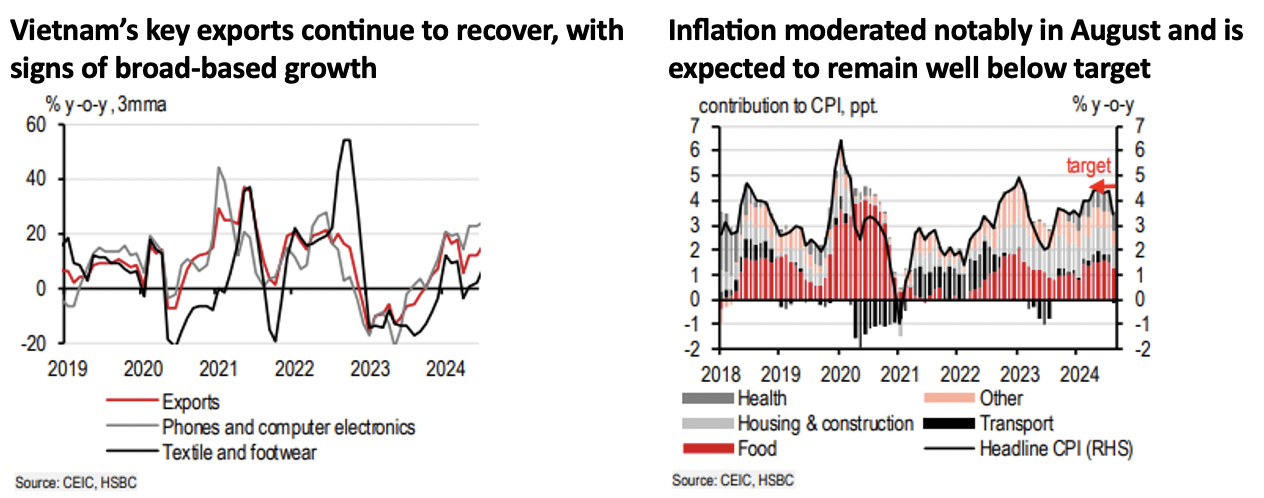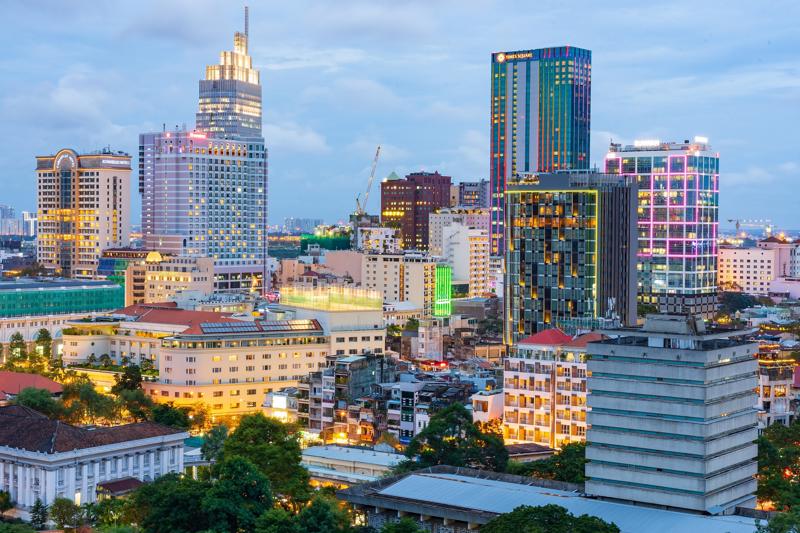The report: Asian Economics Quarterly - Comin’ in for a landing released by HSBC on September 30, noted that Vietnam’s economic recovery continues to firm up as the Year of the Dragon progresses.
"We believe the potential upside risks can offset the temporary economic disruptions from Typhoon Yagi," the report noted. "All in all, we maintain our GDP growth at 6.5 per cent for both 2024 and 2025."
Risks occur
According to the report, Typhoon Yagi has hit Vietnam particularly hard after making landfall on 7 September 2024. The government has reportedly estimated damage worth $1.6 billion with widespread flooding and damage across factories, warehouses, and power infrastructure. Although recovery efforts and a resumption of operations are under way, the after-effects of Asia’s strongest typhoon so far this year are expected to persist for weeks.
Prime Minister Pham Minh Chinh has called for all efforts to restore livelihoods to achieve the government’s growth target of 7 per cent, which is higher than that set by the National Assembly of 6 - 6.5 per cent at the end of 2023.
In addition to global energy prices, Vietnam is also vulnerable to food shocks. For instance, pork prices have been elevated as pork supply has been affected by African Swine Fever. That said, pressure on some agricultural products is expected to lessen as the weather transition from El Niño to La Niña brings more favourable harvesting conditions to Southeast Asia.
Finally, whether end-demand for goods improves further will be key in determining the strength of Vietnam’s recovery, as Western markets make up close to half of Vietnam’s exports. The trajectory and pace of consumer spending in the West will therefore need to be closely watched.
Waiting for further lift
Despite the challenges, growth improved and surprised on the upside in the second quarter of 2024, rising 6.9 per cent year-on-year. The recovery in the external sector has started to broaden out beyond consumer electronics, although the pass-through to lifting the domestic sector still remains to be seen.
For one, the manufacturing sector has emerged strongly from last year’s woes. PMIs have registered five consecutive months of expansion, while industrial production (IP) has registered a bounce-back in activity for the textiles and footwear industry as well. This has supported robust export growth at double digits, with structural forces, such as expanding market access for Vietnamese agricultural produce, also underway.
However, the domestic sector is recovering more slowly than initially expected, with retail sales growth still below the pre-pandemic trend. Encouragingly, the government has put in place measures to support a wide range of domestic sectors that is expected to shore up confidence with time. Environment tax cuts on fuel and value-added tax cuts for certain goods and services will last until year-end 2024, while the revised Land Law effective from August will buttress the outlook for real estate. Albeit still early, the latter seems to have already contributed to a boost in foreign investment in the sector, with recent FDI showing broad-based gains.
On inflation, price developments are turning more favourable in the first half of 2024, as unfavourable base effects from energy have faded. An expected Fed easing cycle will also help to alleviate some exchange rate pressures.
"Taking all these into consideration, we maintain our inflation forecasts at 3.6 per cent in 2024, well below the State Bank of Vietnam’s target ceiling of 4.5 per cent. For 2025, we keep our inflation forecast at 3.0 per cent," the report noted.

On foreign investment, newly registered FDI was up 35 per cent year-on-year for the first eight months of 2024. Intra-ASEAN investments are leading the way, making up 40 per cent of inflows to date. Existing investors continue to make commitments. Amkor Group invested an additional $1.07 billion in its semiconductor project, supporting Vietnam’s expanding manufacturing capabilities. Foreign investment into the real estate sector has also risen over recent months. This is likely being supported by the revised Land Law effective August, which relaxed some regulations to spur demand.
In addition, Vietnam has received over 11 million international tourists to date. This has helped to buoy certain components of retail sales: tourism sales were up 26 per cent in the first eight months of the year, compared to total retail sales growth of 8.5 per cent. Eventual spillover from a resurgent manufacturing sector, as well as fiscal and monetary support should embolden household spending with time. Albeit already robust, there are still many avenues to improve Vietnam’s tourism prospects further. For instance, despite making up a third of tourist arrivals pre-pandemic, mainland Chinese tourists still require a visa to travel to Vietnam.
Notably, Vietnam’s digital economy has potential to become the second largest in ASEAN by 2030. Based on the e-Conomy SEA report by Google, Temasek, and Bain & Company, Vietnam was the fastest growing digital economy in ASEAN last year. This is being driven by a growing consumer population savvy with the internet. Digital transformation is also being driven by the government and businesses. For example, there is still room to raise the usage of online platforms and digital signatures when handling official documents. However, challenges remain. The development of human capital and infrastructure has not kept pace with economic growth. Encouragingly, the government and private sector are taking steps to address these areas.
Policy issues
President To Lam was elected as the General Secretary of the Communist Party of Vietnam Central Committee on 3 August 2024. He succeeded the late General Secretary Nguyen Phu Trong, who passed away on 19 July 2024 at age 80. Party General Secretary To Lam has stressed the importance of socio-economic development, and has already met with foreign leaders to develop bilateral relations.
"Evidently, these reflect Vietnam’s commitment to working and engaging with the broad international community," the report noted. "Other initiatives, such as the investment support fund to incentivise foreign firms to set up base in Vietnam in consideration of the global minimum tax, are also underway."
Currently, work towards the 14th National Congress of the Communist Party of Vietnam is underway, which is scheduled to take place in early 2026.










 Google translate
Google translate